Discover the Crunch of Chinese Crispy Noodles (Chow Mein)
Imagine biting into a crispy noodle dish that’s full of Asian flavors. Chinese Crispy Noodles, or Chow Mein, is a favorite in many places. It’s a mix of stir-fried noodles, veggies, and sometimes meat or tofu.
Chinese Crispy Noodles (Chow Mein) is perfect for those who love Asian noodles or want to try something new. It’s quick to make, taking about 35 minutes. Each serving has 340 calories, 19 grams of protein, and 3 grams of fiber.
Key Takeaways
- Chinese Crispy Noodles (Chow Mein) is a popular Chinese-American dish made with stir-fried noodles, vegetables, and sometimes meat or tofu.
- A standard serving of Chicken Chow Mein includes 340 calories, 19 grams of protein, and 3 grams of fiber.
- The preparation time for Chow Mein is approximately 35 minutes, making it a great option for a quick and easy meal.
- Chow Mein is made from dried noodles, while lo mein typically uses fresh egg noodles.
- The cooking method for Chow Mein involves stir-frying the noodles, veggies, and chicken together to achieve a caramelized and crispy texture.
- Chinese Crispy Noodles (Chow Mein) can be customized with various ingredients, such as vegetables, meat, or tofu, to suit your taste preferences.
- With its rich history and versatility, Chow Mein has become a staple in many restaurants and households across the United States.
The History and Origins of Chinese Crispy Noodles
Chinese crispy noodles, also known as Chow Mein, have a long history. They date back to the Han Dynasty in China. As a key part of Authentic Chinese cuisine, Chow Mein has grown and spread to other places, like the United States. The name “Chowmein” comes from Cantonese, where “Chow” means stir-fried and “mein” means noodles.
Chow Mein is a well-liked Noodle dish that has changed in different places. In the United States, it has local flavors, with hot sauces and gravies added. Traditional Chinese noodles are essential in Chow Mein. They can be made in many ways and can have different proteins and vegetables.
Some notable variations of Chow Mein include:
* Indian-style Chow Mein, a favorite street food in cities like Kolkata
* Peruvian Chow Mein, also known as “Tallarín Saltado”, with local vegetables and chicken, steak, or seafood
* Caribbean-style Chow Mein, with local spices and ingredients like pork sausages and prawns
The history of Chinese crispy noodles shows how versatile and adaptable they are. This makes them a favorite Noodle dish worldwide.
Essential Ingredients for Perfect Chinese Crispy Noodles
To make perfect Chinese Crispy Noodles, also known as Stir-fried noodles, you need a few key ingredients. These include noodles, vegetables, and sometimes meat or tofu. The most popular choice is Crispy chow mein noodles.
A typical serving of chicken Chow Mein has about 589 calories. It has 27g of total fat, 5g of saturated fat, and 144mg of cholesterol. It’s also high in sodium, with 1946mg per serving. But it’s a good source of dietary fiber, with 5g per serving, and protein, with 33g per serving.
The following table summarizes the nutritional information for a serving of chicken Chow Mein:
| Nutrient | Amount per serving | Daily Value |
|---|---|---|
| Calories | 589 | |
| Total Fat | 27g | 42% |
| Saturated Fat | 5g | 31% |
| Cholesterol | 144mg | 48% |
| Sodium | 1946mg | 85% |
| Total Carbohydrates | 55g | 18% |
| Dietary Fiber | 5g | 21% |
| Protein | 33g | 66% |
By using these essential ingredients and following a few simple tips, you can create delicious and authentic Stir-fried noodles and Crispy chow mein dishes at home.
Understanding Different Types of Noodles for Chow Mein
Choosing the right noodle for Chinese Crispy Noodles, or Chow Mein, is key. Asian noodles vary in shape, size, and ingredients. For Chow Mein, you can pick between fresh or dried noodles, based on what you like and what’s available.
Fresh noodles are often preferred for their texture and taste. However, they can be pricier and have a shorter shelf life than dried noodles. Dried noodles, while more convenient and lasting longer, might not have the same texture and flavor as fresh ones. Popular noodle types include egg noodles, wheat noodles, and rice noodles, each offering a unique taste and texture.
When picking a noodle for your Chow Mein, consider these points:
- Freshness: Fresh noodles are preferred for their texture and flavor, but they can be more expensive and have a shorter shelf life.
- Ingredient: Egg noodles, wheat noodles, and rice noodles are popular options, each with its own distinct taste and texture.
- Convenience: Dried noodles are more convenient and can be stored for longer periods, but they may lack the texture and flavor of fresh noodles.
The noodle type you choose depends on your taste and what’s available. Knowing about different noodles helps you make great Noodle dishes that highlight the best of Asian noodles.
Mastering the Art of Chinese Crispy Noodles (Chow Mein)
To master Chinese Crispy Noodles (Chow Mein), you need patience and practice. Perfecting the technique of cooking these noodles takes dedication. With the right ingredients and techniques, you can make delicious Wok-fried noodles at home.
Here are some tips to help you master Chinese Crispy Noodles:
- Choose the right noodles, like fresh or dried, based on your taste.
- Cook noodles until they are al dente for the best texture.
- Stir-fry noodles with the right oil and seasonings for great flavor.
By following these tips and practicing, you can become a pro at making Chinese Crispy Noodles. Your family and friends will love the delicious Wok-fried noodles you make. Always use fresh ingredients and try different seasonings and sauces to find your favorite.
Proper Wok Techniques for Crispy Noodle Perfection
To get the perfect crispy texture in your Wok-fried noodles, mastering the right wok techniques is key. The high heat and quick stir-frying of the wok keep the noodles crunchy. With these techniques, you can make a tasty and authentic Chinese dish quickly.
First, controlling the wok’s temperature is crucial. A hot wok is needed for stir-frying. It cooks ingredients fast and keeps them from getting soggy. To check if the wok is hot, flick a few drops of water onto it. If they sizzle and disappear right away, it’s ready to cook.
Choosing the right oil for stir-frying is also vital. Use oils with a high smoke point, like vegetable or peanut oil, to avoid burning. Also, use the right amount of oil. Too little can make ingredients stick, while too much can make the dish greasy.
Stirring the ingredients properly is key for crispy noodles. Stir them quickly and constantly with a spatula. This even heat distribution prevents burning and sticking to the wok.
Common Mistakes to Avoid When Making Crispy Noodles

When making Crispy chow mein, it’s key to steer clear of common mistakes. One big error is overcooking the Asian noodles. This makes them mushy and not tasty.
Another mistake is using the wrong ingredients. This includes low-quality sauces or not enough seasonings. To get the perfect Crispy chow mein, use the right stuff. This means dark soy sauce, toasted sesame oil, and vegetable bouillon cube.
Here are some common mistakes to avoid when making Crispy chow mein:
- Overcooking the Asian noodles
- Using low-quality sauces or inadequate seasonings
- Not stir-frying the ingredients quickly enough, resulting in a lack of crispiness
By avoiding these mistakes and using the right ingredients and techniques, you can make delicious Crispy chow mein. It will impress your family and friends.
Delicious Sauce Combinations and Toppings
When it comes to Stir-fried noodles, the sauce and toppings really matter. In Authentic Chinese cuisine, finding the right balance is key. A great sauce can enhance the noodles’ flavor and texture. The right toppings add crunch, freshness, and excitement.
Popular sauces for Stir-fried noodles include soy, oyster, and hoisin. Mixing these in different ways can create unique flavors. For instance, soy and oyster sauce mix for a savory taste. Hoisin and rice vinegar mix for a sweet and sour taste.
There are countless toppings for Stir-fried noodles. You can use sliced veggies like carrots and bell peppers. Or add chicken or tofu for protein. Nuts, seeds, and fresh herbs like green onions and cilantro are also great options.
Here are some tips for making your own tasty sauce and topping combinations for Stir-fried noodles:
- Try different sauce mixes to find your favorite.
- Add your favorite toppings to make it your own.
- Think about the flavor of the sauce and toppings when choosing.
By trying these tips and experimenting, you can make your own special Stir-fried noodles dish. It will show off the flavors and traditions of Authentic Chinese cuisine.
Serving and Presentation Tips

When serving Chinese Crispy Noodles, also known as Chow Mein, aim for a dish that looks great. Choose a big serving dish to hold the noodles and your toppings. This could be veggies, meat, or seafood.
Use a mix of colors and textures to make the dish interesting. Top your crispy noodle recipes with green onions, bean sprouts, and carrots. These add color and freshness. Sesame seeds or chopped scallions can add a nutty flavor and crunch.
Here are some more tips for serving and presentation:
- Use different veggies like cabbage, celery, and bell peppers for color and texture.
- Add a protein like cooked chicken, beef, or tofu to make it more filling.
- Be creative with your toppings and garnishes. The more colorful, the better it looks.
Follow these tips to make a tasty and attractive noodle dish. It will impress your family and friends. Whether it’s for a dinner party or a quick meal, have fun and be creative with your presentation.
Health Benefits and Nutritional Information
Traditional Chinese noodles are a nutritious choice in Authentic Chinese cuisine. A single serving of Chinese Crispy Noodles (Chow Mein) has 457 calories. It also has 18g of total fat, 39g of carbohydrates, and 33g of protein.
The dish is a good source of dietary fiber, with 6g per serving. It also has vitamins A, C, and iron. But, it’s important to watch the sodium content, with 893mg per serving.
To make a healthier version of Traditional Chinese noodles, use low-sodium ingredients. Add more vegetables, like Chinese cabbage. It’s full of vitamins and minerals.
- 16% of the daily recommended calcium per cup
- 64% of vitamin K per cup
- Low in calories, making it an excellent option for weight loss
- Rich in vitamin C, supporting the immune system and eye health
By choosing the right ingredients and cooking methods, you can enjoy the health benefits of Chinese noodles. This way, you can keep your diet balanced.
Conclusion: Bringing Restaurant-Quality Chow Mein to Your Kitchen
You can make Crispy chow mein just like restaurants at home. It’s all about using the right ingredients and cooking methods. Web sources say authentic ingredients and Wok-fried noodles techniques are key.
To make it happen, focus on the ingredients, cooking, and how you present it. Here are some important tips:
- Choose fresh veggies and lean proteins for a tasty dish.
- Learn to cook Wok-fried noodles well by controlling heat and oil.
- Make your Crispy chow mein look good with fresh herbs and a nice presentation.
Follow these tips and keep practicing. Soon, you’ll be making Crispy chow mein and Wok-fried noodles like a pro at home. Don’t be afraid to try new things and make the dish your own.
Final Thoughts and Recommendations
Now that you’ve learned about Chinese Asian noodles, it’s time to start making noodle dishes at home. Making Chinese Crispy Noodles (Chow Mein) is a journey. It’s filled with trying new things and being creative.
Don’t be shy to try new recipes and mix up the ingredients. Adjust the seasonings to your liking. This way, you’ll get better at making delicious Chow Mein dishes.
As you practice, you’ll make dishes that taste just like the ones from your favorite restaurants. You’ll discover the amazing flavors and textures of Chow Mein. And you can add your own twist to it.
This will not only wow your loved ones but also help you appreciate Chinese cooking more. So, go ahead and enjoy the process of creating your own delicious noodle dishes.







